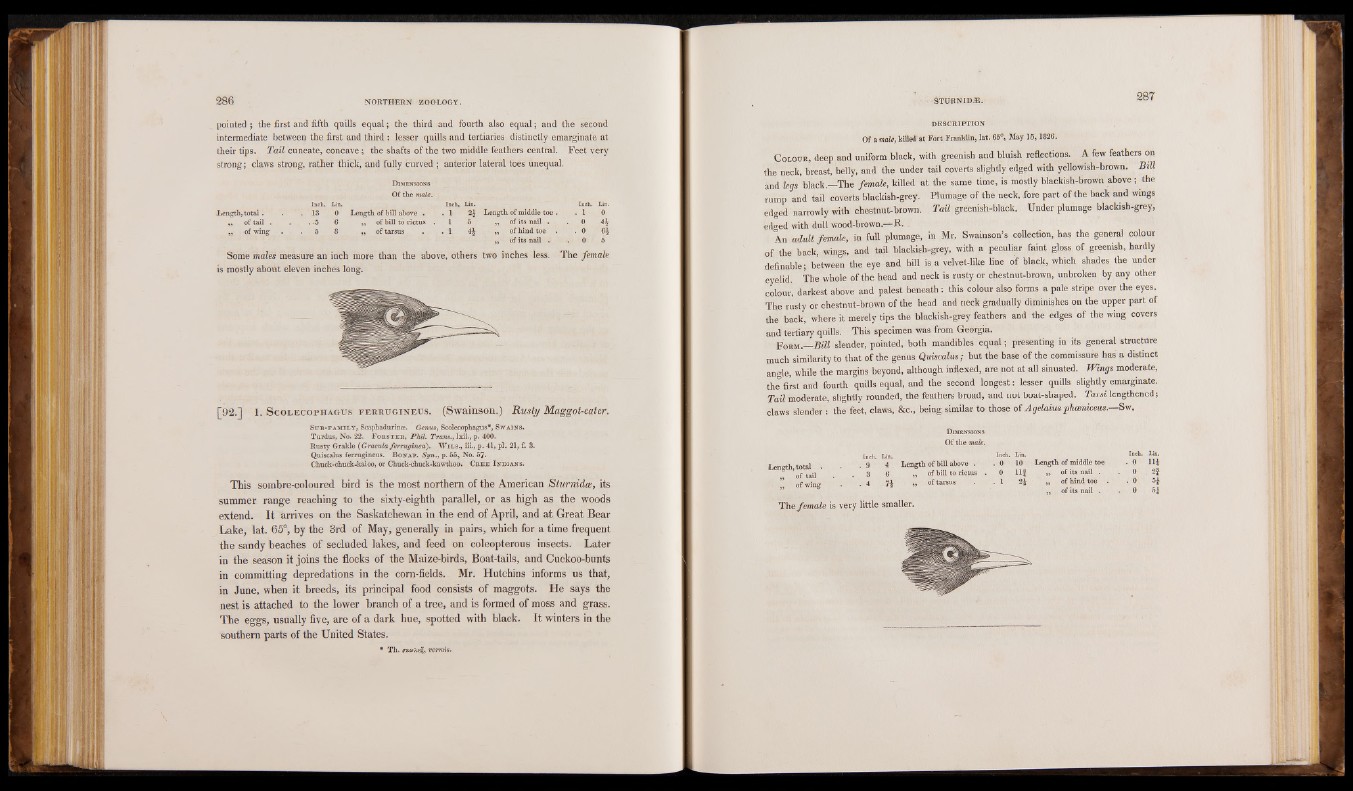
pointed ; the first and fifth quills equal; the third and fourth also equal; and the second
intermediate between the first and third : lesser quills and tertiaries distinctly emarginate at
their tips. Tail cuneate, concave; the shafts of the two middle feathers central. Feet very
strong; claws strong, rather thick, and fully curved ; anterior lateral toes unequal.
Dimensions
Of the male.
Inch. Liiu Inch. Lin. 'Inch. Lin.
Length, total. . 13 0 Length of hill above . . 1 24 Length of middle toe ., . 1 0
„ of tail . . . -5 6 „ of bill to rictus . 1 5 „ of its nail . 0 4£
„ of wing . • 5 8 ,, of tarsus . 1 44 „ of hind toe . 0 4
„ of its nail . . 0 5
Some males measure an inch more than the above, others two inches less. The female
is mostly about eleven inches long.
[92.1 1. S c o l e c o p h a g u s f e r r u g in e u s . (Swainson.) R usty Maggot-eater.
Sxjb-f a m il y , Scaphadurin*. Genus, Scolecophagus*, Sw ains.
Turdus, No. 22. F o b s t e b , Phil. Trans., Ixii., p. 400.
Rusty Grakle (Gracula ferrugined). W il s ., iii., p. 41, pi. 21, f. 3.
Quiscalus ferrugineus. B o nap. Syn., p. 55, No. 57>
Chuck-chuck-kaioo, or Chuck-chuck-kawthoo. Cb.e e I ndians.
This sombre-coloured bird is the most northern of the American Sturnidce, its
summer range reaching to the sixty-eighth parallel, or as high as the woods
extend. It arrives on the Saskatchewan in the end of April, and at Great Bear
Lake, lat. 65°, by the 3rd of May, generally in pairs, which for a time frequent
the sandy beaches of secluded lakes, and feed on coleopterous insects. Later
in the season it joins the flocks of the Maize-birds, Boat-tails, and Cuckoo-bunts
in committing depredations in the corn-fields. Mr. Hutchins informs us that,
in June, when it breeds, its principal food consists of maggots. He says the
nest is attached to the lower branch of a tree, and is formed of moss and grass.
The eggs, usually five, are of a dark hue, spotted with black. It winters in the
southern parts of the United States.
Th. trxtaX'/iZ, vermis.
DESCRIPTION
Of a mote, killed at Fort Franklin, lat. 65°, May 15, 1826.
Colour, deep and uniform black, with greenish and bluish reflections. A few feathers on
the neck, breast, belly, and the under tail coverts slightly edged with yellowish-brown. Bill
and legs black.—The female, killed at the same time, is mostly blackish-brown above ; the
rump and tail coverts blackish-grey. Plumage of the neck, fore part of the back and wings
e d g e d narrowly with chestnut-brown. Tail greenish-black. Under plumage blackish-grey,
edged with dull wood-brown
An adult female, in full plumage, in Mr. Swainson’s collection, has the general colour
of the back, wings, and tail blackish-grey, with a peculiar faint gloss of greenish, hardly
definable; between the eye and biU is a velvet-like line of black, which shades the under
eyelid. The whole of the head and neck is rusty or chestnut-brown, unbroken by any other
colour, darkest above and palest beneath: this colour also forms a pale stripe over the eyes.
The rusty or chestnut-brown of the head and neck gradually diminishes on the upper part of
the back, where it merely tips the blackish-grey feathers and the edges of the wing covers
and tertiary quills. This specimen was from Georgia.
Form.—Bill slender, pointed, both mandibles equal; presenting in its general structure
much similarity to that of the genus Quiscalus ; but the base of the commissure has a distinct
angle, while the margins beyond, although inflexed, are not at all sinuated. Wings moderate,
the first and fourth quills equal, and the second longest: lesser quills slightly emarginate.
Tail moderate, slightly rounded, the feathers broad, and not boat-shaped. Tarsi lengthened;
claws slender : the feet, claws, &c., being similar to those of Agelaius phceniceus.—Svi.
Dimensions
Of the male.
Inch. Lin.
of middle toe . 0 11 £
of its nail . . 0 2f
of hind toe . . 0 5£
of its nail . . 0 5 *
Inch. Lin. Inch. Lin.
Length, total . , . 9 4 Length of bill above . . 0 10 Length
of tail . 3 6 5» of bill to rictus . 0 Ilf
. ” of wing . . 1 I t >, °f tarsus . .1 2 i „
The female is very little smaller.